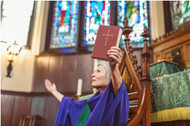COGIC Class A Vestments: Who and When Do Clergy Wear Them?
Mar 28th 2023
When it comes to the traditional vestments worn by clergy, there is a wide variety of options to choose from. But for members of the Church of God in Christ (COGIC), there is a specific type of vestment known as Class A Vestments.
These vestments are a symbol of the clergy’s commitment to their faith and the COGIC denomination, and must be worn at all times when conducting official church business, such as leading services, taking part in official church events, and conducting baptisms.
COGIC clergy members are required to wear these specific vestments during services and other formal occasions. Pastors, bishops, and other ordained clergy members are required to wear them as part of their duties.
But what makes COGIC Class A Vestments special? Let’s explore their significance and what it means for the members of the Church.
What are COGIC Class A Vestments?
COGIC Class A Vestments refer to the official clerical clothing worn by ordained clergy members of the Church of God in Christ. These vestments are specifically designed to distinguish clergy members from the rest of the congregation and to serve as a symbol of their authority and sacred calling.
These vestments are the official robes of the Church of God in Christ (COGIC) and are used for formal worship services and other occasions. They typically consist of a robe and a stole. The robe is usually made from a heavy fabric and features a high collar and long sleeves.
The stole is a long, narrow piece of fabric that is draped around the neck and shoulders and is often decorated with embroidery or other embellishments. Both the robe and stole are meant to symbolize the authority and holiness of the wearer.
The Components of COGIC Class A Vestments
Class A Vestments are composed of several different pieces, each of which has its own specific purpose and meaning. Let’s look at the components and their significance and meaning.
The Cassock
The first component is the cassock, a long robe that is typically black in color. The cassock is worn over the clergyman’s street clothes and serves as a reminder of their commitment to the church.
The Surplice
The next component is the surplice, which is a white robe with long sleeves and a high collar. This is worn over the cassock and is a symbol of purity and holiness.
The Stole
The third component is the stole, which is a long, narrow piece of cloth that is draped over the shoulders. This symbolizes the authority of the clergyman, and is a reminder of the responsibility they have to their congregation.
Black Tippet
A black tippet is an essential part of a clergy's wardrobe. It is a long, narrow scarf that is typically worn draped over the shoulders and around the neck. It is traditionally made of black wool and is often adorned with a cross or other religious symbol.
The tippet is a symbol of authority and respect, and it is a sign of humility and service to the church. It is also a reminder of the priest's commitment to the service of God and the community. A tippet is an important part of a clergy's identity, and it is a powerful symbol of one's dedication to the service of God.
Cincture Belt
A cincture belt is an important component of the class A vestments worn by clergy. This belt is made of fine fabrics such as silk, wool, or cotton, and is usually decorated with embroidery. It is typically worn around the waist and tied in front to symbolize the yoke of Christ.
The cincture helps to keep the vestments in place and it can also be used to hang other items, such as the priest's stole. It is a reminder to the clergy to remain humble and obedient to the will of God.
When are COGIC Class A Vestments Worn?
When it comes to when to wear these vestments, the most important factor is the type of service or event that is taking place. For example, it is expected that clergy will wear COGIC Class A Vestments when leading Sunday services, preaching, and presiding over baptisms.
It is also expected that the clergy will wear Class A Vestments when taking part in official church events, such as ordinations, dedications, and funerals. Finally, it is expected that clergy will wear Class A Vestments when visiting other churches, as a sign of respect for their host.
In addition to the above-mentioned occasions, these vestments may also be worn when attending special functions, such as weddings, anniversaries, and other celebrations. However, for more casual events, such as Bible studies or youth meetings, it is acceptable for the clergy to wear a clergy shirt and collar, or even street clothes.
Know the Value of Wearing the Right Clergy Wear
COGIC Class A Vestments are an important aspect of the Church of God in Christ's tradition and serve as a symbol of the clergy members' authority and sacred calling. These vestments can distinguish clergy members and help them fulfill their roles as spiritual leaders.
At Divinity Clergy, we understand the importance of Class A Vestments and the symbolism they represent. Our vestments are made from the highest quality materials, and are designed to be both comfortable and stylish.
We are committed to providing the best products and services to our customers, and strive to ensure that our vestments are a symbol of their commitment to their faith and the COGIC denomination.
